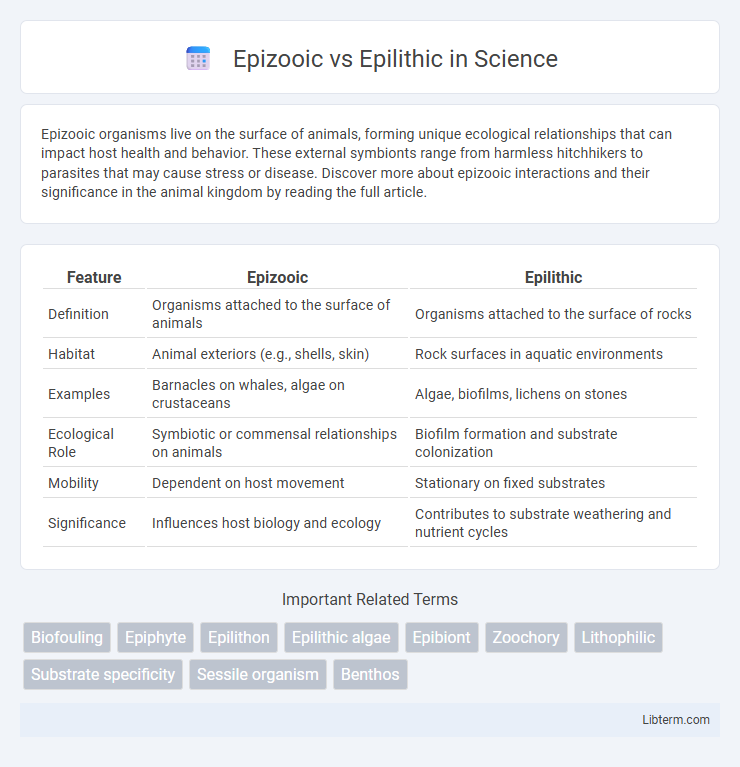Epizooic organisms live on the surface of animals, forming unique ecological relationships that can impact host health and behavior. These external symbionts range from harmless hitchhikers to parasites that may cause stress or disease. Discover more about epizooic interactions and their significance in the animal kingdom by reading the full article.
Table of Comparison
| Feature | Epizooic | Epilithic |
|---|---|---|
| Definition | Organisms attached to the surface of animals | Organisms attached to the surface of rocks |
| Habitat | Animal exteriors (e.g., shells, skin) | Rock surfaces in aquatic environments |
| Examples | Barnacles on whales, algae on crustaceans | Algae, biofilms, lichens on stones |
| Ecological Role | Symbiotic or commensal relationships on animals | Biofilm formation and substrate colonization |
| Mobility | Dependent on host movement | Stationary on fixed substrates |
| Significance | Influences host biology and ecology | Contributes to substrate weathering and nutrient cycles |
Introduction to Epizooic and Epilithic Concepts
Epizooic organisms live attached to the surface of animals, often forming complex communities on hosts like crustaceans, fish, and marine mammals, influencing their ecology and behavior. In contrast, epilithic organisms colonize hard substrates such as rocks and stones in aquatic environments, playing critical roles in biofilm formation and nutrient cycling. Understanding the distinctions between epizooic and epilithic communities helps elucidate their ecological interactions and contributions to biodiversity in marine and freshwater ecosystems.
Defining Epizooic: Life on Animal Surfaces
Epizooic organisms live on the external surfaces of animals, such as fish or crustaceans, deriving benefits from their hosts without causing harm. This mode of existence contrasts with epilithic organisms that inhabit rocky substrates in aquatic environments. Studying epizooic relationships reveals insights into host-specific adaptations and ecosystem interactions on animal surfaces.
Understanding Epilithic: Life on Rock Surfaces
Epilithic organisms thrive on rock surfaces, forming complex communities that contribute significantly to ecosystem functions such as nutrient cycling and habitat formation. Unlike epizooic species that live on animals, epilithic life adapts to withstand harsh environmental conditions including exposure to sunlight, desiccation, and variable temperatures. Understanding epilithic biofilms and algae reveals critical insights into primary production in aquatic and terrestrial habitats, influencing biodiversity and geological processes.
Key Differences Between Epizooic and Epilithic Communities
Epizooic communities consist of organisms living on the surface of animals, such as crustaceans on whales, whereas epilithic communities inhabit the surfaces of rocks in aquatic environments. Epizooic organisms often exhibit adaptations for attachment to moving hosts and dynamic environments, while epilithic species develop mechanisms for strong adhesion on stationary substrates exposed to water currents. The difference in substrate type--living hosts versus inorganic rock surfaces--directly influences community structure, species interactions, and ecological roles within these habitats.
Examples of Epizooic Organisms
Epizooic organisms, such as barnacles and copepods, live attached to the surface of animals like whales and crabs, distinguishing them from epilithic organisms that colonize rock surfaces, like lichens and algae. Barnacles are a prime example of epizooic species, thriving on marine mammals and providing a robust model for symbiotic relationships. Copepods, often found on fish skin and gills, further exemplify epizooic fauna critical for studying marine ecosystem dynamics.
Examples of Epilithic Organisms
Epilithic organisms, such as lichens, algae, and diatoms, colonize rock surfaces in aquatic and terrestrial environments, forming biofilms that contribute to nutrient cycling and habitat stability. Unlike epizooic organisms, which live on animal hosts like barnacles on whales, epilithics thrive on inorganic substrates, often serving as primary producers in ecosystems. These organisms play a crucial role in preventing erosion and supporting microbial communities on rocky shorelines and freshwater benthic zones.
Ecological Roles and Significance
Epizooic organisms live on the surface of animals, playing critical roles in marine ecosystems by facilitating nutrient recycling and serving as food for predators, thereby maintaining biodiversity and ecological balance. Epilithic organisms inhabit rock surfaces, contributing to primary production and biofilm formation, which supports a wide range of aquatic life and prevents erosion. Both epizooic and epilithic communities enhance habitat complexity and influence energy flow across marine and freshwater environments.
Adaptations in Epizooic vs Epilithic Species
Epizooic species exhibit adaptations such as specialized attachment structures like holdfasts or suction discs to secure themselves on mobile hosts, enabling mobility and access to nutrients. Epilithic species possess adaptations including strong adhesive pads or mucilaginous coatings to withstand harsh water currents and desiccation on rock surfaces. Both demonstrate morphological and physiological traits tailored to their substrates, optimizing survival in dynamic aquatic ecosystems.
Environmental Factors Influencing Distribution
Epizooic organisms colonize the surfaces of living animals, while epilithic organisms inhabit non-living rocky substrates, with their distribution influenced by factors such as substrate availability, water flow, and nutrient concentration. Epizooic communities are often shaped by host mobility and immune response, whereas epilithic assemblages depend on light exposure, sedimentation rates, and wave action. Environmental parameters like salinity gradients and temperature fluctuations further determine the spatial patterns and species composition within these two distinct ecological niches.
Applications and Research in Epizooic and Epilithic Studies
Epizoic organisms, which live on the surface of animals, are studied for their roles in marine ecology, biofouling prevention, and host health assessment, providing insights into symbiotic relationships and parasite-host dynamics. Epilithic communities, composed of microorganisms and algae attached to rock surfaces, are crucial in biofilm research, water quality monitoring, and understanding primary production in aquatic ecosystems. Both epizooic and epilithic studies utilize molecular techniques and microscopy for biodiversity assessment, contributing to environmental management and conservation strategies.
Epizooic Infographic

 libterm.com
libterm.com